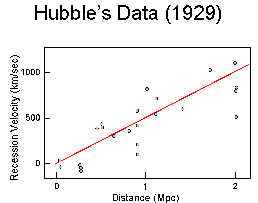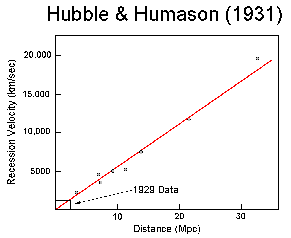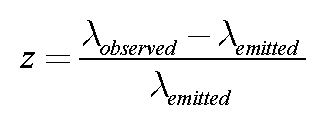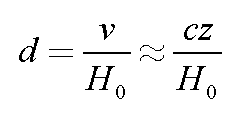Astronomy 162: Introduction to Stars, Galaxies, and Cosmology
Todd Thompson
Department of Astronomy
The Ohio State University
Lecture 33: The Expanding Universe
- Hubble's Law
- Galaxies are receding from us.
- Recession velocity gets larger with distance.
- The Hubble Parameter (H0)
- Measures the present-day rate of expansion of the Universe.
- Cosmological Redshifts
- Due to the expansion of space
- Redshift distances
- Redshift maps of the Universe
V = H0 d
Discovery of Expansion
1917: work by Vesto Slipher at Lowell Observatory
- Measured radial velocities from spectra of 25 galaxies.
Found:
- 21 of the 25 show a redshift
- speeds of some >2000 km/sec
Most galaxies are rapidly receding from us.
Hubble's Discovery
1929: Edwin Hubble measured distances to 25 galaxies:
- Used cepheids for Andromeda and Local Group
- Used brightest stars in the others
- Compared distances with recession velocities.
Discovered:
- Recession velocity gets larger with distance.
Systematic expansion of the Universe.

- Edwin Hubble's 1929 expansion data
(Graphic by R. Pogge)

- Refined version by Hubble & Humason in 1931
- [Based on the data in the original Astrophysical Journal
papers.]
(Graphic by R. Pogge)

(Graphic by R. Pogge)
- v = recession velocity in km/sec
- d = distance in Mpc
- H0 = expansion rate today (Hubble Parameter)
In words:
- The more distant a galaxy, the faster its recession
velocity.
Interpretation
Hubble's Law demonstrates that the Universe is expanding in a
systematic way:
- The further away a galaxy is from us, the faster it appears
to be moving away from us.
- Hubble Parameter: Rate of expansion of the Universe
- H0 is the value of the Hubble Parameter today.
Comments:
- Hubble's Law is empirical - based only on data in its original
form.
- Not an exact law.
Nature of the Expansion
General Expansion of Spacetime:
- All observers in different galaxies see the same expansion
around them.
- No center - all observers appear to be at the center.
What is the recession velocity?
- NOT motion through space...
- Expansion of spacetime: galaxies carried along.

- As the Universe get 2x larger, the distances between galaxies get 2x larger.
Note:
- While the distances between galaxies increase over time, the
sizes of the galaxies remain the same. This is because galaxies
are bound together by gravitation locally, and so do not share in
the global expansion of spacetime around them.
Hubble Parameter: H0
Measures the rate of expansion of the Universe today.
- H0 = 70 +/- 7 km/sec/Mpc
- Best measurement to date is from the Hubble Key Project to measure
Cepheids in nearby galaxies.
H0 is very hard to measure
- Recession speeds are easy to measure from the shifts of
spectral lines.
- But, distances are very hard to measure.
- Galaxies also have extra (non-cosmological) motions that must be
taken into account.
Cosmological Redshifts
All galaxies (with very few exceptions) are receding from us.
The recession is quantified in terms of the "cosmological
redshift" of the galaxy, z:

(Graphic by R. Pogge)
The above is not a Doppler Shift! It measures the expansion of
spacetime, not motions through space.
As the universe expands, light waves get stretched out:
- Stretching makes the wavelength longer, hence redder
- Result is a "Cosmological Redshift"
Animated GIF of Cosmological Redshift,
courtesy of Wayne Hu, at the
University of Chicago.
Redshift Distances
For relatively nearby galaxies, the redshift is directly proportional
to the distance, through the Hubble Law:

(Graphic by R. Pogge)
where
- z = cosmological redshift
- c = speed of light
This formula is only valid for relatively nearby galaxies.
Limitations:
- Value of H0 is only known to ~10%
- Random motions of galaxies affects measurements of z for nearby
galaxies (random motions are comparable to recession velocity)
- At large distances, the conversion between cosmological redshift
and distance is much more complicated, depending on the geometry
of spacetime and the expansion history of the Universe.
Nonetheless, because cosmological redshift is a direct observable
related to distance, it used as a surrogate for distance, especially
for distant galaxies.
Mapping the Universe
We can map the large-scale distribution of galaxies using their cosmological
redshifts.
The largest map to date
is from the 2dF Galaxy Redshift Survey, which includes about 220,000
galaxies:
- Reveals sheets and filaments of galaxies surrounding great voids.
- Depth is about 500-600 Mpc
- Relative distances are good, but the absolute scale
is good to only about 10%
Dedicated 2.5-meter telescope in New Mexico
Making images of 1/4 of the sky in 5 colors:
- Accurate positions and photometry for a few 100 Million stars,
galaxies, & quasars.
Redshift Survey:
- 1 Million galaxy redshifts
- 100,000 quasar redshifts
One of the results will be a 3D map of a large segment of the local universe.
Updated/modified January 2011 by Todd Thompson
Copyright Richard W. Pogge,
All Rights Reserved.







